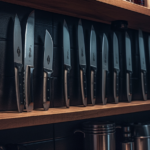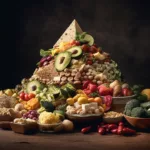Table of Contents
Discover the Ideal Fruits to Cultivate in Your Backyard Garden and Create Mouthwatering Jams with Minimal Effort!
Do you love homemade jam as much as I do? There’s nothing quite like the taste of fresh berry or fruit jam on a warm slice of toast in the morning. But if you’re tired of buying jam at the store or paying premium prices for artisanal jams, why not grow your own fruits in your kitchen garden instead? Not only will you have a ready supply of fruit for your jams, but your homegrown jams will also taste much better too. In this article, I’ll share with you the best fruits to grow in your backyard garden to make the most delicious and flavorful jams.
Consider the climate and soil type
If you’re thinking about growing fruits in your kitchen garden for delicious jams, the first thing you’ll need to consider is the climate and soil type in your area. Different fruits thrive in different climate zones, and soil types play a crucial role in determining the yield and quality of your crops.
Climate considerations
Before you decide which fruits to grow, you’ll need to assess your local climate. Some fruits grow well in cooler regions, while others require hot and humid environments. Here are some fruits that grow best in different climate zones:
- Cooler regions: Blueberries, raspberries, blackberries, and strawberries.
- Moderate regions: Apples, pears, peaches, and plums.
- Warmer regions: Citrus fruits, figs, grapes, and melons.
Soil type considerations
The soil type in your garden can also affect the growth and yield of your fruit plants. Certain fruits prefer well-drained soils, while others thrive in moist soils. Here are some tips on the best soil types for various fruits:
- Strawberries: Grow best in well-drained soil with a slightly acidic pH.
- Blueberries: Need well-drained, acidic soil with a pH range of 4.0 to 5.0.
- Apples: Grow best in loamy soil that drains well but retains some moisture.
- Pears: Prefer well-drained, slightly acidic soils.
- Peaches: Need well-drained, nutrient-rich soils with a slightly acidic pH.
In conclusion, before undertaking your kitchen garden project, it’s essential to research the climate and soil type of your area and make decisions based on this information. By doing this, you’ll be able to maximize your yield and grow delicious fruits for your jam-making endeavors.
Choose high-yielding fruit varieties
When it comes to growing fruits in your kitchen garden, choosing high-yielding varieties can make all the difference in the quality and quantity of your jams. Here are a few of the best high-yielding fruit varieties to consider:
1. Strawberries: Strawberries are a classic choice for homemade jams, and for good reason. They grow well in a variety of climates and soil types, and they produce fruit for several months each year. Look for day-neutral varieties, which produce a continuous crop throughout the growing season, or June-bearing varieties, which produce a large crop in early summer.
2. Raspberries: Raspberries are another excellent choice for homegrown jam. They’re easy to grow, and they produce fruit for several weeks each season. Look for summer-bearing or fall-bearing varieties, which will produce a large crop in a short amount of time.
3. Blueberries: If you live in a cooler climate, blueberries are a great option for homemade jam. They’re easy to grow, and they produce fruit for several weeks each summer. Look for highbush varieties, which grow well in a variety of soil types and produce large, flavorful fruit.
4. Blackberries: Blackberries are another excellent option for homemade jam. They’re easy to grow and produce fruit for several weeks each season. Look for thornless varieties, which are easier to prune and maintain.
When choosing high-yielding fruit varieties for your kitchen garden jams, keep in mind that different varieties may perform better in different climates and soil types. Be sure to do your research and choose varieties that are well-suited to your area. With a little bit of planning and preparation, you can enjoy delicious homemade jam all year round!
Opt for disease-resistant fruit trees and bushes
When choosing fruits for your kitchen garden, it’s essential to select plants that are disease-resistant. Not only does this prevent the spread of diseases among your plants, but it also ensures healthy, high-yielding fruit. Here are some tips on choosing disease-resistant fruit trees and bushes:
Research fruit tree and bush varieties
Before you start growing fruit, research the different types of fruit tree and bush varieties available. Some fruit varieties are more resistant to diseases than others. So, it’s essential to select disease-resistant plants that perform well in your region. For example, some varieties of apple trees are resistant to apple scab, while others are susceptible to it.
Choose resistant rootstocks
The rootstock is an essential factor to consider when selecting fruit trees. Many fruit tree growers graft the fruit tree onto a rootstock that’s resistant to diseases. For example, many apple varieties are grafted onto the M9 rootstock, which is resistant to diseases like fire blight.
Consider your climate and soil type
Different fruit varieties thrive in different climates and soil types. For example, high humidity is a common cause of fruit tree diseases like apple scab, so it’s better to choose varieties that do well in your climate. Similarly, some fruit trees and bushes prefer acidic soil, while others prefer alkaline soil. By choosing a variety that’s adapted to your local conditions, you can reduce the risk of disease and increase the chances of a successful harvest.
In conclusion, selecting disease-resistant fruit trees and bushes is essential when growing fruit for your kitchen garden. By doing research and choosing the right varieties, rootstocks, and growing conditions, you can prevent the spread of diseases and ensure healthy, high-yielding fruit.
Grow your own organic fruit with minimal maintenance
If you’re looking to make delicious jams from fruits that you’ve grown in your own backyard, here are some of the best fruit options to consider. In this article, we’ll explore the essential features to keep in mind when selecting fruits that are ideal for your kitchen garden jams.
Opt for Disease-Resistant Fruit Trees and Bushes
When choosing fruit trees and bushes, it’s important to select varieties that are disease-resistant. By doing so, you can avoid the hassle and expense of having to diagnose and treat fruit trees for various types of fungal or bacterial infections. Disease-resistant varieties are often bred to have built-in immunity against some of the most common fruit diseases, such as powdery mildew or apple scab. This means that you can enjoy healthy, high-yielding fruit crops each year without too much effort.
Choose High-Yielding Fruit Varieties
Another important consideration when choosing fruits for your kitchen garden jams is the yield of the fruit. You’ll want to opt for fruit varieties that produce a high yield without sacrificing flavor. Some of the most high-yielding fruit options include:
- Strawberries
- Blueberries
- Blackberries
- Raspberries
- Apples
These fruits produce abundant crops that can easily be used to make delicious jams, preserves, or desserts.
Consider the Climate and Soil Type
Selecting fruits that are well-suited to your climate and soil conditions is another crucial consideration when growing your own fruit. Some fruit varieties thrive in hot, dry climates, while others prefer more temperate conditions with ample rainfall. It’s also important to ensure that your soil type is suitable for growing the fruits you’re interested in cultivating. For example, blueberries prefer acidic soil with a pH level of around 4.5 to 5.5, and strawberries prefer well-drained soil that’s high in organic matter.
By keeping these essential factors in mind, you can select the best fruits for your kitchen garden jams and ensure that you have healthy, high-yielding fruit trees and bushes that require minimal maintenance. So why not start growing your own delicious, organic fruits today? With a little bit of effort, you’ll soon have an abundant supply of fresh fruit for your jams, baking, and snacking!
Conclusion
Growing your own fruits for your kitchen garden jams is a fun and rewarding experience. Not only does it provide you with fresh, organic produce, but it also gives you the satisfaction of creating your own homemade jams. Remember to choose fruits that are suitable for your climate and soil type, as well as high-yielding and disease-resistant varieties. With proper care and maintenance, you can enjoy a bountiful harvest of fruits and make the most delicious jams with minimal effort. So, roll up your sleeves, get your hands dirty, and start growing your own fruits for your kitchen garden jams today!









